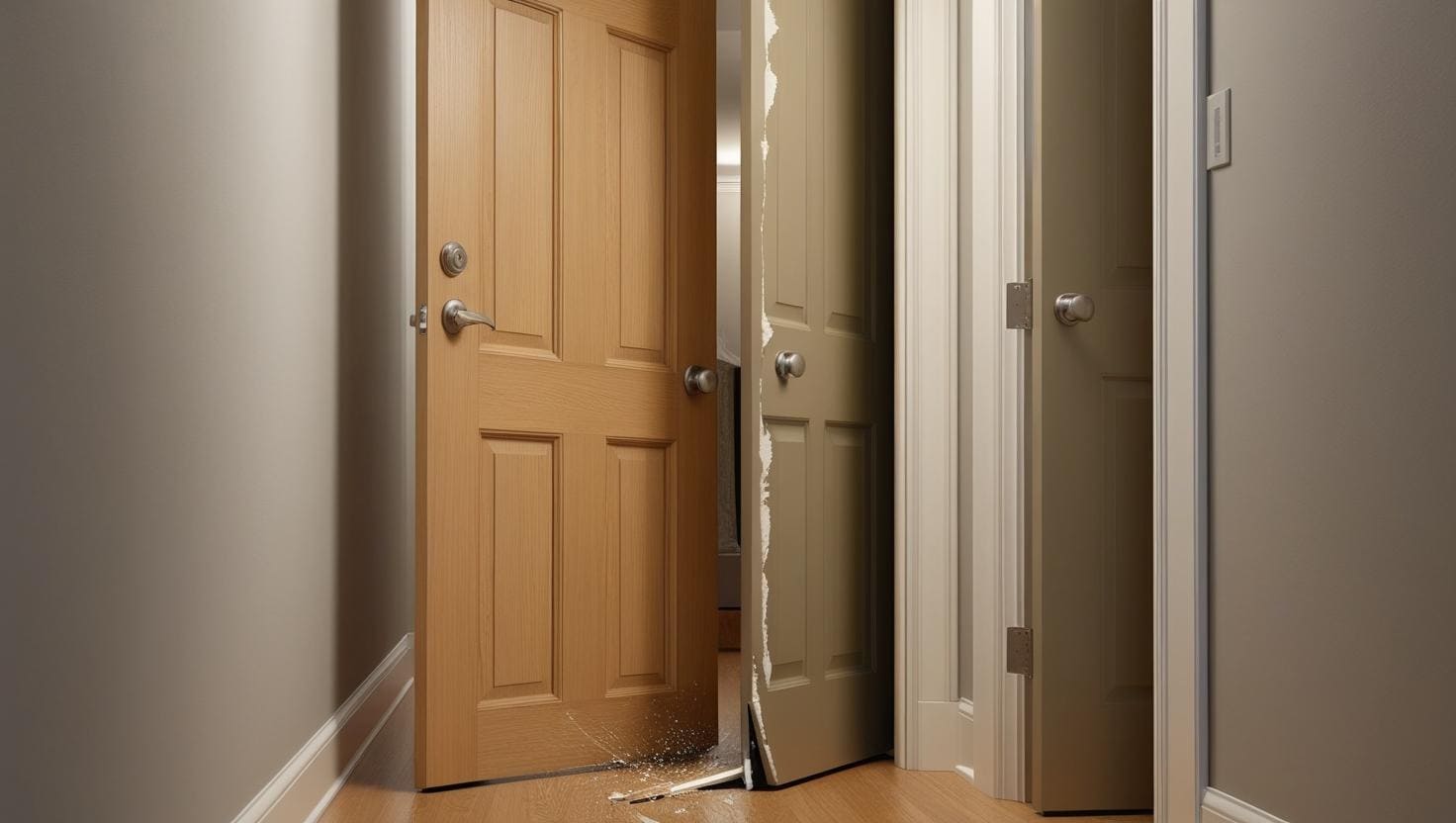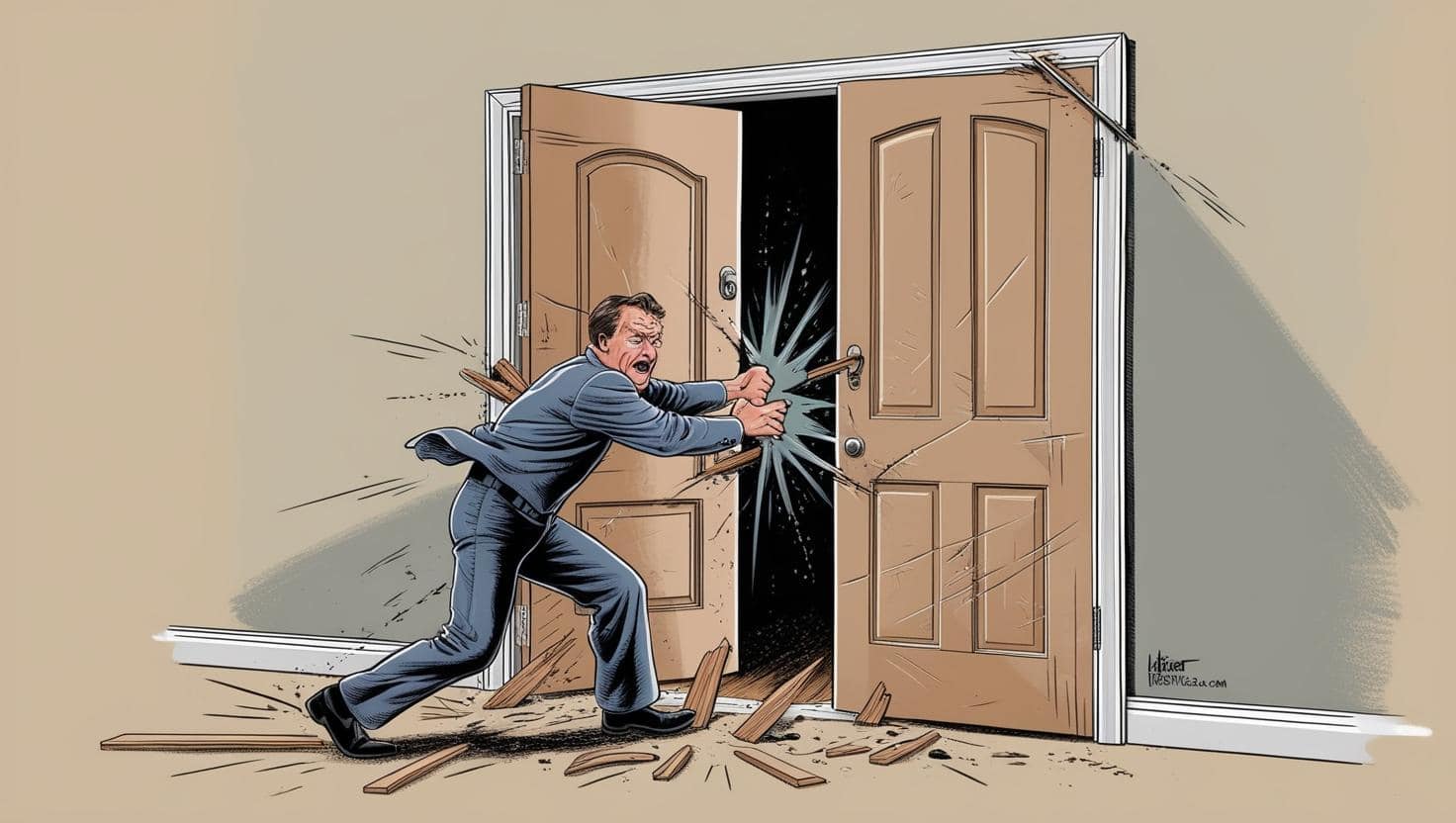Introduction
Have you ever opened your front door only to have it crash into your closet door? It’s frustrating, isn’t it? The loud bang, the potential damage, and the annoyance of dealing with doors that just won’t cooperate can make anyone dread entering their own home.
This common issue, where a closet door and front door hit each other, happens more often than you might think. Whether you’re in a cozy apartment or a spacious house, poor door placement or design flaws can lead to this problem. But don’t worry—there are practical solutions and preventive measures to fix it.
In this article, we’ll dive into why closet doors and front doors collide, explore actionable solutions to stop it, and share tips to prevent it from happening again. By the end, you’ll have a clear plan to make your entryway functional and stress-free.
Why Do Closet Doors and Front Doors Hit Each Other?

When a closet door and front door hit each other, it’s usually a result of design or installation issues. Understanding the root causes is the first step to finding a lasting fix. Let’s break down the most common reasons:
1. Poor Space Planning
Many homes, especially older ones or compact apartments, suffer from poor space planning. If the front door swings into a narrow entryway where a closet door is located, the two doors may compete for the same space. According to the National Association of Home Builders, about 30% of homes built before 1980 have entryway design flaws that lead to spatial conflicts like this.
- Example: In small apartments, builders often place a coat closet near the front door to maximize storage. However, if the closet door swings outward, it can collide with the front door.
2. Incorrect Door Swing Direction
The direction in which a door swings—either inward or outward—plays a big role. If both the front door and closet door swing toward each other, they’re likely to clash. For instance, an inward-swinging front door paired with an outward-swinging closet door is a recipe for trouble.
3. Limited Clearance Space
Doors need enough clearance to open fully without hitting other objects. The standard clearance for a door swing is about 36 inches, but in tight entryways, this space is often reduced. When the closet door and front door don’t have enough room to operate independently, collisions are inevitable.
4. Improper Installation
Sometimes, the issue comes down to shoddy installation. If hinges are misaligned or doors are hung incorrectly, they may not open or close as intended, increasing the chance of hitting each other.
5. Wear and Tear Over Time
Doors can shift over time due to settling foundations, loose hinges, or warped frames. A door that worked fine when installed might start hitting the other door years later as the house settles.
The Impact of Doors Hitting Each Other
When a closet door and front door keep colliding, it’s more than just an inconvenience. Here are some consequences to consider:
- Damage to Doors: Repeated impacts can chip paint, dent wood, or crack glass panels.
- Safety Hazards: A sudden collision could catch someone off guard, potentially causing injury, especially in households with children or elderly residents.
- Frustration: Constantly adjusting how you open doors to avoid a crash is annoying and disrupts daily routines.
- Reduced Home Value: Visible damage or poor functionality in the entryway can make your home less appealing to potential buyers.
Now that we know why this happens and why it’s a problem, let’s explore how to fix it.
Solutions for When Closet Doors and Front Doors Hit Each Other

Fixing the issue of a closet door and front door hitting each other doesn’t always require a major renovation. Here are practical solutions, ranging from quick fixes to more involved projects, depending on your budget and skill level.
1. Install a Door Stop
A door stop is one of the simplest and most affordable solutions. It prevents either door from opening too far and hitting the other. Door stops come in various types, such as wall-mounted, floor-mounted, or hinge-pin stops.
- How to Do It:
- Determine which door is easier to restrict (usually the closet door).
- Choose a door stop that suits your space. For example, a wall-mounted stop works well if you have enough wall space.
- Install the stop according to the manufacturer’s instructions, ensuring it limits the door’s swing before it hits the other door.
- Cost: $5–$20 per stop.
- Pro Tip: Magnetic door stops can hold the door in place, adding extra convenience.
2. Change the Door Swing Direction
If the doors are swinging toward each other, reversing the swing of one door can solve the problem. For example, making the closet door swing inward instead of outward might create enough clearance.
- How to Do It:
- Remove the door from its hinges.
- Relocate the hinges to the opposite side of the door frame.
- Adjust the strike plate and latch on the door frame to match the new swing direction.
- Cost: $50–$150 for tools and hardware, or $200–$500 if hiring a professional.
- Note: This solution may not work in very tight spaces where inward swings still cause issues.
3. Replace One Door with a Different Style
Sometimes, the type of door itself is the issue. Swinging doors take up more space than alternatives like sliding or bifold doors. Replacing the closet door with a sliding or bifold option can eliminate collisions entirely.
- Options:
- Sliding Doors: These glide along a track, requiring no swing space. They’re ideal for tight entryways.
- Bifold Doors: These fold in half when opened, reducing the space needed compared to a standard swinging door.
- Pocket Doors: These slide into the wall, completely freeing up the entryway.
- Cost: $100–$500 for materials, plus $200–$800 for professional installation.
- Example: A homeowner in a small condo replaced their swinging closet door with a barn-style sliding door, instantly solving the collision issue while adding a trendy aesthetic.
4. Adjust or Realign Hinges
If the doors are hitting because of misalignment, tightening or adjusting the hinges can help. Over time, hinges can loosen, causing the door to sag and encroach on the other door’s space.
- How to Do It:
- Inspect the hinges for loose screws and tighten them with a screwdriver.
- If the door is still misaligned, add shims behind the hinges to adjust the angle.
- Test the door’s swing to ensure it no longer hits the other door.
- Cost: $0–$10 for shims or replacement screws.
- Pro Tip: Use a level to check if the door is hanging straight.
5. Install a Door Coordinator
In some cases, both doors need to remain swinging but can be coordinated to avoid collisions. A door coordinator is a device used in double-door setups to ensure one door closes before the other opens, preventing them from hitting.
- How to Do It:
- Purchase a door coordinator compatible with your door sizes and frame.
- Install it according to the manufacturer’s instructions, typically at the top of the door frame.
- Test the doors to ensure smooth operation.
- Cost: $50–$150 for the coordinator, plus installation costs if needed.
6. Create a Physical Barrier
If other solutions aren’t feasible, consider adding a small barrier, like a decorative post or a piece of furniture, to limit how far one door can open. For example, a narrow console table in the entryway can act as a natural stop for the front door.
- Cost: $50–$300, depending on the furniture or barrier chosen.
- Pro Tip: Choose a barrier that complements your home’s decor to maintain a cohesive look.
Preventing Closet Doors and Front Doors from Hitting Each Other
Prevention is always better than a cure. If you’re designing a new home, renovating, or just want to avoid future door collisions, here are some tips to keep in mind:
1. Plan Your Entryway Carefully
When designing or renovating, work with an architect or contractor to ensure the front door and closet door don’t compete for space. Consider the following:
- Measure Clearance: Ensure at least 36 inches of clearance for each door’s swing.
- Test Door Swings: Mock up the door swings during the planning phase to identify potential conflicts.
- Opt for Alternative Doors: Choose sliding or bifold doors for closets near entryways.
2. Choose the Right Door Type from the Start
If you’re building or upgrading, select door types that suit small spaces. Sliding doors, pocket doors, or bifold doors are excellent choices for closets near front doors.
3. Regular Maintenance
Keep doors in good condition to prevent misalignment or warping, which can lead to collisions over time.
- Check Hinges: Tighten screws every 6–12 months.
- Inspect Frames: Look for signs of warping or settling and address them early.
- Lubricate Hinges: Use WD-40 or a similar lubricant to keep hinges moving smoothly.
4. Work with Professionals
If you’re unsure about door placement or installation, hire a professional contractor or carpenter. They can assess your space and recommend solutions tailored to your home’s layout.
Real-Life Examples and Statistics
To bring this issue to life, let’s look at a couple of real-world scenarios:
- Case Study 1: Urban Apartment Fix: Sarah, a renter in a Chicago apartment, dealt with a front door that hit her closet door every time she entered. The tight entryway left little room for both doors to swing. She installed a $15 wall-mounted door stop on the closet door, which solved the problem without damaging the rental property.
- Case Study 2: Suburban Home Renovation: The Johnson family in a 1970s suburban home had a front door that collided with a coat closet door. They replaced the closet door with a bifold door for $300, eliminating the issue and improving the entryway’s look.
According to a 2023 survey by Houzz, 25% of homeowners reported issues with door functionality in their homes, with entryway conflicts being a top complaint. Investing in solutions like door stops or alternative door styles can save time, money, and frustration in the long run.
Conclusion
Dealing with a closet door and front door hitting each other can feel like a daily battle, but it’s a problem with straightforward solutions. Whether you opt for a quick fix like a door stop or a more permanent change like a sliding door, you can restore peace to your entryway.
By understanding the causes—poor planning, incorrect swings, or misalignment—and taking steps to prevent future issues, you’ll create a functional and welcoming entrance to your home.
Take a moment to assess your space, try one of the solutions we’ve outlined, and enjoy the freedom of doors that work harmoniously. Have you faced this issue in your home? Share your experience or let us know which solution worked for you!
FAQ’s
1. Can I fix this issue without replacing a door?
Yes! Simple solutions like door stops or hinge adjustments can often resolve the problem without major changes.
2. How much does it cost to replace a closet door with a sliding door?
Expect to spend $100–$500 on materials and $200–$800 on professional installation, depending on the door type and labor rates in your area.
3. Is it safe to reverse a door’s swing direction myself?
If you’re handy with tools, you can do it, but it requires precision. If you’re unsure, hire a professional to avoid damaging the door or frame.
4. What’s the easiest fix for doors hitting each other?
A door stop is the quickest and cheapest solution, often costing less than $20 and taking under 30 minutes to install.






More Stories
35 Witchy Halloween Decor Ideas for a Spooky and Stylish Home Transformation
30 Yellow Living Room 2025 Ideas That Will Brighten Your Home with Warmth, Color, and Style
Transform Your Outdoor Space with Decoradyard: Ideas, Tips, and Inspiration